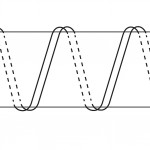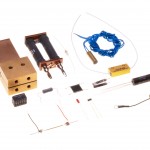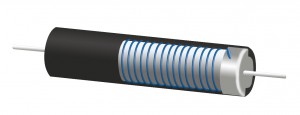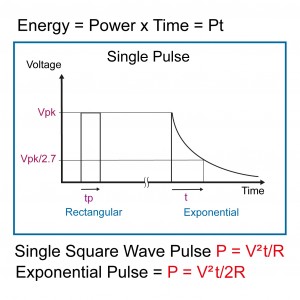Like every component, the fabrication technology used in resistor manufacture has changed over time and resistive films have made a significant contribution in allowing the cost-effective mass production of devices that are increasingly miniaturized. Yet the traditional wirewound resistor, despite a substantial decline in the number of manufacturers of this component in recent decades, remains the best solution for many specialized applications.
Construction advantages
One reason for the survival of wirewound resistors is that all of the alternative fabrication techniques have drawbacks. For example, the use of conductive inks to produce carbon film or thick film resistors can produce very low-cost components but the resulting devices have limited pulse handling, no better than 0.1% initial tolerance and poor long-term stability, typically 500 to 1000ppm/year. The resistance is temperature dependent, with a temperature coefficient of resistance (TCR) of around 50 to 100ppm/°C. Moreover, relatively high current noise of -18 dB to -10 dB is typical, where:
dB = 20 x log (noise voltage [in μV]/DC voltage [in V])
Figure 1: Easy customization is one of the major advantages of wirewound resistor technology, as shown in these examples from Riedon.
Carbon composition resistors, made by binding conductive carbon powder and an insulating material (usually ceramic) in a resin are some of the earliest resistor types. The proportions of carbon and insulating material determine the desired resistance value. It’s difficult to achieve accurate values so ±5% is often the best initial tolerance available and they exhibit poor temperature stability with a TCR of some 1000ppm/C. These resistors also have high current noise (-12 dB to +6 dB ) and suffer from poor stability over time.
Metal film types perform better. They deliver improved tolerance (as good as 0.01%), TCR of 20 to 200ppm/°C and stability of 200 to 600ppm/yr. But these figures still cannot match those of wirewound alternatives, and their pulse handling capability is significantly inferior.
As a result of the limitations of other technologies, wirewound components continue to be used in many applications. They can handle high level pulses and transients, can dissipate substantial amounts of power (some are rated at up to 2.5kW), and they can be made with great precision – some have initial tolerances down to 0.005%. Just as importantly, they are stable (15 to 50ppm/yr), maintaining their precision over time because they are made with stable materials. Wirewound resistors also are among the lowest current noise resistors available at -38dB.
The basic structure of a wirewound resistor has remained unchanged for many years. As the name suggests, a resistance wire is wound around a central core or former, usually made of ceramic. Metal end-caps are pressed onto the core, and the resistance wire welded to them. Finally, the assembly is encapsulated to protect it from moisture and physical damage.
Figure 2: The fundamental construction of a wirewound resistor has changed little over time.
Wirewound construction also produces devices that are easy to customize, so engineers have the freedom to specify exactly what they need, even if the final quantities required are in the hundreds, rather than tens of thousands. And although familiar, the technology has not stood still. For instance, advances in materials science allow the construction of devices with tightly controlled response across a range of temperatures, with TCR as low as 1ppm/°C.
The individual component’s resistance is determined by the length, cross-sectional area, and material (and hence resistivity) of the resistive wire. In terms of material choice, a small diameter copper wire 30m long may have a resistance of a few ohms. In contrast, the higher resistivity of nickel alloy means that a small diameter wire only 30cm long made of this material may have a resistance of several thousand ohms.
Manufacturers of wirewound resistors offer a choice of metal alloys and sizes and the fabrication characteristics go a long way to explaining the advantages. When a high precision resistor is required, for example, a longer resistance wire can be used, allowing the value to be trimmed to great accuracy by removing a few centimeters (or even millimeters) of wire.
Temperature stability
The choice of material is also the major factor influencing the temperature characteristic of the resistor. For example, low-TCR “Evenohm” alloy is formulated to have a TCR of 5 to 10ppm/°C. For comparison, pure nickel has a TCR of 6700ppm/°C, and copper a TCR of 3900ppm/°C.
The material choice therefore allows the manufacturer to tailor the resistor to desired characteristics. In general, low TCR is desirable. However, in some situations, such as temperature sensing and compensation applications, the opposite may be true, since the specific purpose of these components is to respond to changes in temperature.
Wirewound components are sometime chosen for their ability to continue operating in extreme temperatures. Devices such as Riedon’s UT series of axial resistors, for example, operate from -55°C to 275°C, and continue to function at even higher temperatures with de-rating. These capabilities make the technology well-suited for use in the aerospace industry, and in applications such as fire suppression systems.
Power handling and energy dissipation characteristics are similarly linked to the physical construction of the device. As a general rule, a resistor with a larger mass can safely absorb and dissipate more instantaneous power and more energy overall, and this is another strength of wirewound technology.
Pulse performance
One common use for wirewound resistors is in pulse handling. A device such as a medical defibrillator needs to dissipate a large amount of energy in a very short time, putting its electrical components under a high degree of stress. To protect these components from failure, engineers typically design-in a resistor that can absorb the energy of a significant millisecond current surge. In another application, wirewound resistors are used to protect a metering module installed in a solid sate electricity meter. Here, the resistor absorbs the high current generated when a metal oxide varistor (MOC) clamps in response to a voltage surge on the grid. Surges can have many causes, including lightning, inductive loads (motors), capacitor banks, switchgear, or even switching heating and ventilation systems in and out of circuit. For these types of application, resistors in the UT series mentioned above are sometimes used. They can withstand over 1000 Joules. Values range from 0.02 Ohms to 260kΩ with tolerances down to ±0.01% and TCR down ±20ppm/°C.
Determining the right pulse handling capabilities for a particular application is not always a straightforward task. Dealing with inrush current implies different requirements than transient suppression. It is not easy to capture within a datasheet all of the information required to make such a choice.
For pulses of up to five seconds, the industrystandard specification is a withstand of five-times rated power for five seconds, so a 5W resistor must be able to handle 25W for 5 seconds (125 Joules), regardless of package size or resistance value.
For shorter pulses, the mass of the resistance wire determines the Joule rating, which is then dependent upon resistor value and package type, including its size and whether it’s an axial or surface mount component. Repetition rate and pulse shape – square, triangular or irregular – also have to be taken into account.
Figure 3: Pulse shape, repetition rate and duration all need to be understood in order to calculate the required energy handling capabilities.
In current sensing applications, designers have different requirements. For example, monitoring battery life in a handheld device generally requires a small package, whereas measurements in industrial or medical equipment might necessitate high precision and high current withstand.
Wirewound devices excel where accuracy is important. For instance, four-terminal components are available in values from 0.01Ω to 1kΩ with tolerances down to 0.005% and current handling capability of up to 25A.
The most commonly cited disadvantage of wirewound resistors, particularly with respect to high frequency applications, is their self-inductance. However, this can overcome with a bifilar winding technique, shown in Figure 4, in which the turns are arranged so that two opposing magnetic fields are created ( one clockwise and the other counterclockwise ), cancelling out the inductance, except the residual amount accounted for by terminations and connecting leads. Inductance is typically reduced by 90% compared to a standard part.
 Figure 4: Non-inductive winding can produce wirewound resistors with minimal self-inductance.
Figure 4: Non-inductive winding can produce wirewound resistors with minimal self-inductance.
Conclusion
From Joule-rated devices for energy absorption to miniaturized components for current temperature sensing, wirewound resistors continue to offer significant advantages over alternatives in many applications.



